- Duration:
- 21 minutes, 51 seconds
Monument Conservation at National Cemeteries: Planning, Management, and Treatment Implementation
Sara Johnson: Going to talk a little bit about a contract that my company has with the National Cemetery Administration for the preservation of a number of monuments in national cemeteries throughout the country. Just a brief background on our client, the National Cemetery Administration is responsible for 131 national cemeteries in 39 U.S. states and Puerto Rico. In addition to the marble government furnished headstones, the NCA's also responsible for the maintenance of hundreds of monuments. A lot of these monuments were erected by individual citizens or groups to commemmorate various events individuals, military units, battles, etcetera. Although a lot of them were originally privately sponsored, they're now the responsibility of the NCA.
As you can see from the photos on the slide, these are all monuments that we treated as a part of this contract. They're all very different, a lot of different monument types and materials. This is our scope of work for our contract. The contract began in October of 2012, and it includes 72 monuments in 28 different national cemeteries in 15 states across the U.S, so literally from coast to coast. The total of the work had to be completed in an 18 month contract period. We did have to pause for winter, because we couldn't perform a lot of the treatments during the cold weather, but in all the treatments had to be done in 18 months. We're nearly done at this point. We still have a few cemeteries to work at in the midwest and in New York, but we are planning to complete in late spring of this year.
My role has been the primary project manager, although it's taken a lot of people to keep the project going. Although I haven't physically worked at all the sites, I've been responsible for a lot of the planning and logistics of the project. There are many different types of monuments that we were treating for the contract. They all were unique, and they all required a different scope of work. We dealt mostly with stone monuments. We had 44 granite monuments, also quite a few marble, as well as some limestone and sandstone monuments. We also worked on a lot of bronze. The vast majority of the bronzes were bronze plaques, but we also had a handful of larger sculptural bronzes.
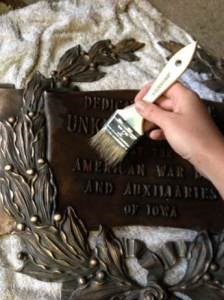
We worked on one zinc monument in Pensacola, Florida, and one guilded copper monument in Mobile, Alabama. We also had a couple of painted stone monuments in which the paint scheme, although probably or maybe not original, was considered historic, so in those cases we were restoring that paint scheme. I should say the majority of the monuments that we treated for this contract dated from mid 19th century to early 20th century. There's a wide range of treatments. The monuments were in varying conditions. Some were in very good condition and required just very basic standard conservation treatments. Others required more complex intervention, sometimes structural interventions.
The most typical stone treatments were cleaning, crack injection with grout, patching with restoration mortar, repointing with either mortar or lead, depending on what was original to the monument. We did have quite a few monuments that had lead pointing, so we repaired those with lead wool. We also performed some consolidation on disaggregating marble monuments. There were a few monuments that required resetting. Some of these monuments had begun to sink or lean to one side as a result of settlement or failure of the subgrade concrete footing. In some cases, we actually had to hoist to monument, excavate the footing, and build a new reinforced concrete footing.
We had some monuments that the different sections of the stone monument were simply mortared together, there was no pinning, so some of them had started to shift on their bases, and we would go in and insert a stainless steel pin to stabilize those. Metal treatments, again this was primarily working with bronze plaques. We did cleaning and corrosion removal, we did patination to even out the tones of patina and to remove green corrosion. Waxing and lacquering, this decision whether to do hot wax or lacquer was based on what was already there on the monument or the plaque. We did a couple of structural interventions in which we inserted armatures into the interior of the monument. The example here is that zinc monument in Pensacola, Florida. This one over the years had become very deformed, because it had no interior support, so we inserted this simple armature to support the weight of the zinc. Then also on that same zinc monument, we did some repairs with metal bulked epoxy to fill some seams and losses in the zinc.
A project of this scale required a huge amount of planning. We really had to develop our own set of internal processes for keeping things standardized. The National Cemetery Administration already has a really good system in place for how they go about monument preservation. Prior to having any contractors starting any work on site, they have a set of assessments done. These are pretty general assessments to identify the major conditions of the monument. Typically either the conservator that performs the assessment or a different conservator will develop a set of preliminary treatment recommendations, and then a different conservator will implement the treatment.
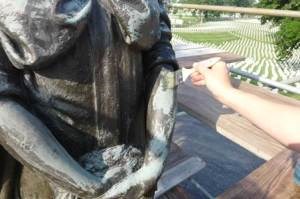
For this contract, we were strictly involved in the implementation phase. When we got the contract, we received all of these previous assessments and treatment recommendations that had been done by other conservators. From those, we began to plan our treatments. We actually visited almost every single monument in person as well before we mobilized for work. The reason for this was because we really wanted to be able to see the monuments first hand, verify the conditions in the field, and have a better basis to develop our treatment plans. We developed a set of pre-treatment documents, these two here are examples from Philadelphia National Cemetery. These were pretty specific documents that identified all the treatments that we were going to perform. We did one of these for every single monument. Typically one for every elevation of every monument.
These plans had to be approved by both the National Cemetery Administration and the State Historic Preservation Office before we could begin work. These were a useful tool not only for planning, but also in the field having these documents to ensure that we actually completed everything that we had planned to. After we had our treatment plans approved, we submitted mobilization plans. This required coordinating with all of the cemetery directors. Every cemetery that we worked at had its own director, and every cemetery was a little bit different. Some of the cemeteries were in very urban locations right in the middle of the city, others were very remote and rural. We didn't really have access to power for most of them, so we had to work off of generators, and often times they weren't able to supply water, so we had to truck in a water tank every day and fill it up at the fire station or the hotel in the morning.
We worked with mostly office scaffolding. Sometimes we would use a manlift if it was more efficient. We were responsible for providing all access. We also had to work with cranes a couple of times for lifting monuments, and sometimes the crane would have to reach halfway across the cemetery in order to access the monument, because obviously it couldn't drive over the graves. It was important to be sure that we protected the landscape and caused no damage when working with this heavy equipment. After we had planned our mobilization, we delivered our equipment materials and staff to the site and began work. We worked at every cemetery anywhere from a few days to a few weeks, depending on the scope. We treated anywhere from 1 to 14 monuments at each cemetery. A lot of the work we were able to perform with our own staff. For many of the cemeteries we worked with sub contractors. Often times we would also hire local technicians to help out with the work.
There are quite a few challenges involved in a project of this scale. We had to assemble a very large team of CSI staff, sub contractors, and technicians. It was really important to maintain quality control and consistency when working with sometimes a different set of staff at every cemetery. Often times we were mobilized in more than one cemetery at a time. We had to be respectful of the environment that we were working within, particularly when working around visitors. A lot of the cemeteries are still very active and have burials and memorial services every day. Sometimes we'd have to pause work 3 or 4 times a day for a service. We had to really plan the work around local climates so that we could get the most out of our working time as possible. We both years had to shut down the contract from about late November through early April, because we couldn't perform the treatments when it was freezing.
We had to really logically plan where we would be working when. This meant working in Pensacola, Florida in March and working in Wisconsin in August. Another challenge was dealing with unforeseen conditions. A lot of these things we had planned one scope, but when we actually mobilized on site and had 100% access, realized that the conditions were much more severe than we had anticipated. These were things that really couldn't be known until we were working on site. Sometimes this would require a change in scope.
Finally, we had to really have an ongoing dialog with the NCA about their preferences, their aesthetic preferences, and what they were wanting to get out of these treatments so that we could be on the same page with them about treatment standards. An example of that is stone cleaning standards. We had to establish what was the appropriate level of clean for stone monuments. Our approach is to use the gentlest means possible to achieve the most effective cleaning results. That means cleaning with detergent and biocide using mild chemical cleaners and microabrasion in moderation as needed to remove really heavy, disfiguring soiling but still accepting a small amount of weathering is appropriate to the monument's age. The NCA was very much on the same page with us about this.
We had some really successful treatments. The photo on the left is a monument in Culpepper National Cemetery, which had some pretty bad orange staining. This is a before and after treatment. The photo on the top right is a heavily soiled granite monument in San Francisco National Cemetery. This is a series of cleaning tests that we did with mild chemical cleaners. The photo on the bottom is a limestone monument, and it's a part of it has been treated, part of it has not. We were able to achieve these cleaning results just with detergent and biocide. Similarly, we had to develop standards for bronze treatment with the NCA. We had a little more discussion about this. Our initial approach was to try to conserve the existing patina as much as possible, and just perform spot patination. That meant using small amounts of patina chemicals in localize areas to even out areas of corrosion or unevenness. This resulted in a patina that was still somewhat weathered.
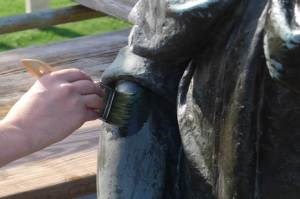
The NCA preferred that the plaques have a really nice, dark, even patina, which we just couldn't achieve through spot patination, so ultimately we ended up performing complete re-patination on plaques and we ended up with this really nice statuary bronze. This is an example from Alexandria National Cemetery. The photo on the top is the original treatment, and then the photo on the bottom is the revised treatment after complete re-patination. I wanted to end by talking about a few of the project examples. These are the most complex projects out of the entire contract, so these are not really representative of what was the average or typical treatment, but they make for the most interesting examples.
This is Major General Sterling Price. He's a 31 foot monument in Springfield National Cemetery, Missouri. The bronze casting was completed in Italy in 1901, and the monument is to commemorate General Sterling Price, who was a Confederate Civil War General, and later Governor of Missouri. The bronze had a lot of issue with iron, because it had both an interior iron armature, as well as a mounting system that was used to mount the sculpture to the base. These iron elements had corroded and caused some significant cracking of the bronze skin. In addition to that, there were several other casting defects, like this joint you see at his neck, which was beginning to open up. Our original plan was to try to conserve the bronze sculpture in place, but this was a situation where once we got to the site and really got 100% access, we realized that the conditions were a lot worse than we had anticipated.
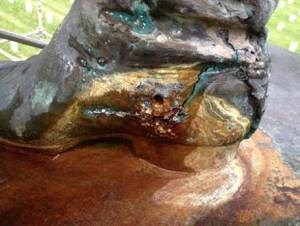
These were things that hadn't been caught in any of the former assessments, either. We had to have a major change in scope. We decided to actually have him taken to foundry where they could perform the repairs more thoroughly. He was removed, shipped from Missouri to New York, and once he was taken down we were able to get this view inside of the monument's self base. The two crossed iron bars that you see were part of the original mounting system, and not only are they severely corroded, but one part of this bar is completely broken off. These are some process photos from the foundry. The first thing they did was, they cut open a window in his back, and found that he was completely full of this clay sand material, which was the original casting material, which was never removed at the foundry. The photo on the top right is a view inside of his leg. This is part of the armature, the original armature was two wrought iron pipes that went up and connected at his hips, and these were what had caused so much corrosion and deterioration in his feet.
The original armature was removed and replaced with a more compatible material. The new armature was pretty similar in design to the original, it consisted of these 2 stainless steel pipes that went through his feet, attached at a top plate at his hips, and then at a bottom plate within the self base. Then he was completely re-patinated to a dark statuary bronze, which was selected by the NCA. Here he is going back, this actually happened yesterday. I received these photos in a text from my boss last night. He was successfully put back in place, and he looks great.
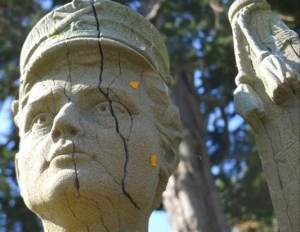
This is a stone example, this is the Thompson Monument from San Francisco National Cemetery. This is an example of a private headstone, but the family had this monument commissioned, it's different from the standard headstone. This is made out of a local collusive sandstone in California that had suffered from a lot of de-lamination, which you can see in his feet, it's very prevalent in those locations. Also, a huge amount of cracking. Very large, severe cracks through his face, but the most alarming crack was the one that you see going through the flag that he held at his side. This was a very large crack, and when we received the assessment documents for this one, they said that he was in danger of collapse, so he needed an emergency stabilization.
The treatment was to just insert a bunch of stainless steel pins through the cracks and try to restore some stability. We were very concerned that the vibrations from the drilling would cause the flag to actually dislodge from his body, so we had to use a lot of support. We used the strut to support the flag from the bottom, and just wrapped him in a bunch of straps. We ended up putting several small pins through his face, and several larger pins through the flag. These pins went all the way through the flag and several inches into his torso. The drill holes as well as the cracks were grouted with an injection grout. The losses were patched with a repair mortar. We ended up with a very successful repair, you can see the finished photo at the bottom right. The grout and the patching mortar were very good color matches, so it was difficult to even tell where the repairs had occurred.
This is a little monument in Rock Island National Cemetery Illinois. This one was dedicated to Colonel David King in 1933, and at some point it had been parged over completely with grey cement for some unknown reason, and the plaque had been painted over with black and aluminum, or silver paint. The paint was so thick that we weren't even certain if this was even a bronze plaque, or if it was some other material. We were able to remove the parge to reveal a really nice sandstone base. It was actually in fairly good condition, and we removed the paint from the plaque and we were able to re-patinate the plaque, and it ended up pretty nice. I think this is a very dramatic before and after here. This is another example of painted plaques. This is in Keokuk National Cemetery, Iowa. Both of these plaques had been painted over multiple times. We were able to remove the paint and re-patinate, coat, and restore the original appearance of these.
This project has required the work of a lot of different people and parties, so I just wanted to thank the NCA, as well as all the sub contractors that we worked with for this.
Last updated: May 18, 2018
